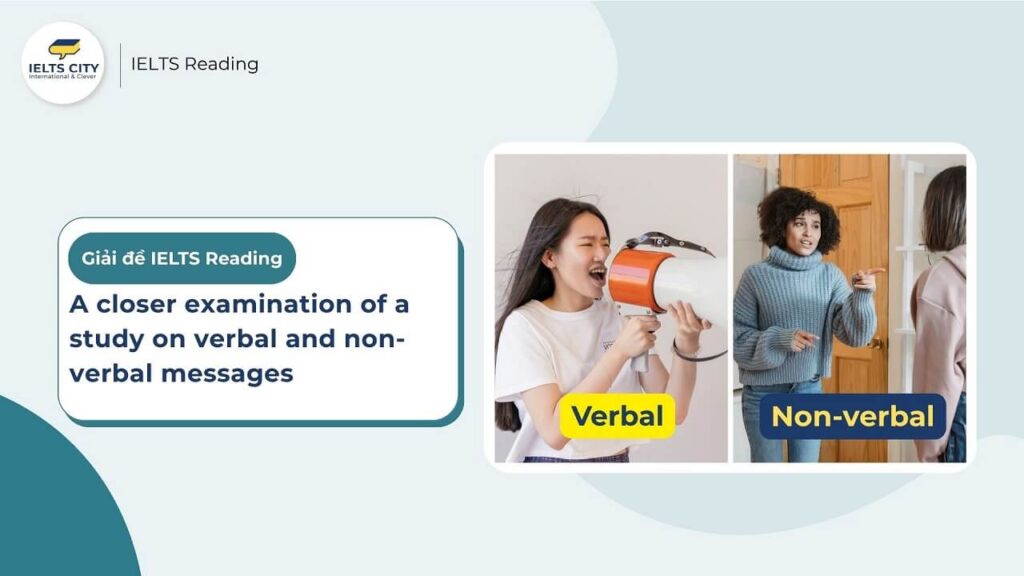
Nội dung chính
ToggleBài đọc
A closer examination of a study on verbal and non-verbal messages
A study of non-verbal communication carried out in 1967 continues to be widely quoted today. David Lapakko looks at limitations in the original study.
Description of the Study
The findings of a study on verbal and non-verbal messages in communication by Albert Mehrabian and his colleagues at UCLA in 1967 have been quoted so frequently that they are now often regarded as a self-evident truth.
In the first experiment, subjects were asked to listen to a recording of a female saying the word ‘maybe’ in three tones of voice to convey liking, neutrality, and disliking. The subjects were then shown photos of female faces expressing the same three emotions and were asked to guess the emotions in the recorded voice and the photos. It was found that the photos got more accurate responses than the voices.
In the second experiment, subjects listened to nine recorded words spoken in different tones of voice. Three words had positive meanings (e.g., honey), three were neutral (e.g., oh), and three were negative (e.g., terrible). Again, the subjects had to guess the speaker’s emotions. It was found that tone of voice carried more meaning than the individual words.
From these experiments, the researchers concluded that 7% of our feeling towards a speaker is based on the actual words they use, 38% on their tone of voice, and 55% on their body language (e.g., facial expression).
Methodological Issues
However, a closer look at the study reveals several limitations. The first is that the entire study involved only 62 subjects. Of these, 25 were used to select the word for the first experiment, while the key issue—comparing verbal and non-verbal communication—was determined by only the 37 remaining subjects. All were female undergraduates who participated as part of their introductory psychology course, and their ages and academic qualifications seem remarkably uniform. Thus, the findings may simply be a product of the nature of the sample.
Critics have also pointed out that the 7-38-55 formula is flawed since it was pieced together from two different experiments, neither of which involved all three channels (verbal, vocal, and facial). In addition, in the first experiment, the single word maybe was used throughout, so it was impossible for the effects of changes in verbal input to be assessed. The researchers intentionally used a “neutral” word so naturally, the subjects found little meaning there. Clearly, such a methodology lacks validity. In the real world, people communicate in a particular context and speak in phrases and full-blown sentences, making extensive use of the multi-faceted vehicle of language.
My concern is that interpretations of this study have gained such prominence in our pedagogical literature. This 7-38-55 formula appears in many basic texts used for training in public speaking, interpersonal communication, and organizational communication.
Lessons to Consider
Clearly, one appealing aspect of the Mehrabian study is its numerical precision. Communication is a complex phenomenon, but it seems less so when we can rely on these three magical numbers. In contrast to the ambiguities of language, numbers seem to possess exactness. And the popular appeal of the study has given the 7-38-55 formula enormous credibility. There is a certain mystique about non-verbal communication, and the continued references to this research sustain it, encouraging people to believe in the overwhelming importance of the non-verbal message compared with the verbal one.
Yet we know that even one well-chosen word to a colleague or friend can make or break a communicative effort. Words do matter. Bradley (1991), one of the few textbook writers to criticize the Mehrabian study, makes the same point when he observes, “If we could communicate 93% of information and attitudes with vocal and facial cues, it would be wasteful to spend time learning a language.”
Mehrabian himself believes his research should not be interpreted to devalue the role of language in communication, saying: “Please remember that all my findings dealt with communications of feelings and attitudes. It is absurd to imply or suggest that the verbal portion of all communication constitutes only 7% of the message… anytime we communicate abstract relationships (e.g., x = y²) clearly 100% of the entire communication is verbal” (Mehrabian, 1996).
To be fair, many textbook writers attempt to be faithful to the context of Mehrabian’s research. For example, Stewart and D’Angele (1988) write: “Mehrabian argues that when we’re uncertain about what someone’s feeling, or about how much we like him or her, we rely… only 7% on the words that are spoken.” Others try to play down the specific percentages, saying that an understanding of the general importance of non-verbal cues is more important. Nonetheless, other textbook authors simply use the numbers without placing any limits on their meaning.
Conclusion
Since this relatively small study was first published, it has achieved an influence far beyond its intended scope. We need to put it into its proper perspective and learn some important lessons from it regarding social science research, communication pedagogy, and the forces which have created widespread misunderstanding about communication.
Kiến thức cần nắm:
Câu hỏi
Questions 27-30
Complete the summary using the list of words and phrases, A-H, below.
Write the correct letter, A-H, in boxes 27-30 on your answer sheet.
Mehrabian’s 1967 study
Albert Mehrabian and his colleagues carried out an influential study comparing the 27……… of verbal and non-verbal communication. This involved two experiments. In both experiments, subjects had to identify the 28…….. being communicated by other people. The two main areas focused on in the first experiment were voice tones and 29………, while the second focused mainly on voice tones and 30……….
A facial expressions
B purposes
C printed words
D effects
E word meanings
F gender differences
G feelings
H characteristics
Questions 31-35
Do the following statements agree with the views of the writer in Reading Passage 3?
In boxes 31-35 on your answer sheet, write:
YES if the statement agrees with the views of the writer
NO if the statement contradicts the views of the writer
NOT GIVEN if it is impossible to say what the writer thinks about this
31. One limitation of the study was that there were too few subjects involved.
32. The fact that the subjects in the study came from a similar background was an advantage.
33. The two experiments should have been carried out in a different order.
34. The researchers’ choice of a neutral word was helpful in the context of the study.
35. The study would have been more valid if it had included a range of languages.
Questions 36-40
Choose the correct letter, A, B, C, or D.
Write the correct letter in boxes 36-40 on your answer sheet.
36. What does the writer say about the numerical precision of Mehrabian’s study?
- A. It makes the claims more attractive.
- B. It is the strongest point of the study.
- C. It will appeal to superstitious people.
- D. It allows comparison between languages.
37. What does the writer say about the popularity of the 7-38-55 formula?
- A. It is unlikely to maintain its present status.
- B. It is leading to an undervaluing of language.
- C. It should be applied in a more practical way.
- D. It may help understanding of non-verbal messages.
38. What point is Bradley making about language learning?
- A. Language could be learned more efficiently than it is.
- B. More research is needed into attitudes to communication.
- C. More should be spent looking at tone and body language.
- D. Language must be important since we make an effort to acquire it.
39. What does Mehrabian himself say about his findings?
A. They are relevant to only one area of communication.
B. It is only in maths that 100% of communication is verbal.
C. Feelings are more difficult to communicate than numerical facts.
D. Non-verbal communication is the main part of the message.
40. What is the writer’s purpose in the paragraph beginning To be fair…?
- A. to justify the strong points of Mehrabian’s study
- B. to outline other research on non-verbal behaviour
- C. to present varying interpretations of Mehrabian’s study
- D. to show that textbooks tend to ignore non-verbal behaviour
Đáp án kèm phân tích
Questions 27-30: Complete the summary
27. D. effects
- Giải thích: Câu tóm tắt nói rằng nghiên cứu so sánh “…” của giao tiếp bằng lời và không lời. Bài đọc mô tả các thí nghiệm so sánh xem kênh nào (lời nói, giọng nói, nét mặt) truyền tải ý nghĩa chính xác hơn hoặc nhiều hơn. Đây chính là việc so sánh “ảnh hưởng” (effects) của các kênh khác nhau.
- Vị trí và trích dẫn: Đoạn 3.”It was found that tone of voice carried more meaning than the individual words.” (Việc so sánh cái nào “mang nhiều ý nghĩa hơn” chính là so sánh “effects”.)
28. G. feelings
- Giải thích: Câu tóm tắt hỏi các đối tượng phải xác định “…” đang được truyền đạt. Bài đọc mô tả thí nghiệm đầu tiên, trong đó các đối tượng phải “đoán các cảm xúc” (guess the emotions) dựa trên giọng nói và hình ảnh. Thí nghiệm thứ hai cũng yêu cầu “đoán cảm xúc của người nói” (guess the speaker’s emotions). “Feelings” (cảm xúc) đồng nghĩa với “emotions”.
- Vị trí và trích dẫn: Đoạn 2 và 3.”…were asked to guess the emotions in the recorded voice and the photos.”
29. A. facial expressions
- Giải thích: Thí nghiệm đầu tiên tập trung vào “âm giọng” (voice tones) và “…” . Đoạn 2 mô tả thí nghiệm này, so sánh “ba âm giọng” (three tones of voice) với “các bức ảnh chụp khuôn mặt nữ” (photos of female faces). “Photos of female faces” chính là “facial expressions” (biểu cảm khuôn mặt).
- Vị trí và trích dẫn: Đoạn 2.”…listen to a recording… in three tones of voice…” và “…shown photos of female faces…”
30. E. word meanings
- Giải thích: Thí nghiệm thứ hai tập trung vào “âm giọng” (voice tones) và “…” . Đoạn 3 mô tả thí nghiệm này, so sánh “các âm giọng khác nhau” (different tones of voice) với các từ có “ý nghĩa tích cực… trung tính… tiêu cực” (positive meanings… neutral… negative). Cuối cùng, kết luận là “âm giọng mang nhiều ý nghĩa hơn các từ riêng lẻ”. Cuộc so sánh ở đây là giữa âm giọng và “ý nghĩa của từ” (word meanings).
- Vị trí và trích dẫn: Đoạn 3.
Đăng ký nhận tư vấn miễn phí
Ưu đãi học phí lên đến 40%
& Cơ hội nhận học bổng trị giá 2.000.000 VNĐ
Đăng ký nhận tư vấn miễn phí
Ưu đãi học phí lên đến 40%
________
Questions 31-35: YES / NO / NOT GIVEN
31. One limitation of the study was that there were too few subjects involved.
- Đáp án: YES
- Giải thích: Người viết (David Lapakko) chỉ ra đây là hạn chế đầu tiên. Ông nói rằng “toàn bộ nghiên cứu chỉ liên quan đến 62 đối tượng” và vấn đề chính chỉ được xác định bởi “37 đối tượng còn lại”. Cách ông trình bày rõ ràng đây là một hạn chế.
- Vị trí và trích dẫn: Đoạn “Methodological Issues”.”The first is that the entire study involved only 62 subjects… the key issue… was determined by only the 37 remaining subjects.”
32. The fact that the subjects in the study came from a similar background was an advantage.
- Đáp án: NO
- Giải thích: Người viết xem đây là một hạn chế, không phải lợi thế. Ông nói rằng tất cả các đối tượng đều “đồng nhất đáng kể” (remarkably uniform) và kết luận: “Do đó, các phát hiện có thể chỉ đơn giản là một sản phẩm của bản chất của mẫu.” Đây là một lời phê bình.
- Vị trí và trích dẫn: Đoạn “Methodological Issues”.”All were female undergraduates… their ages and academic qualifications seem remarkably uniform. Thus, the findings may simply be a product of the nature of the sample.”
33. The two experiments should have been carried out in a different order.
- Đáp án: NOT GIVEN
- Giải thích: Người viết chỉ trích việc công thức 7-38-55 bị “chắp vá lại từ hai thí nghiệm khác nhau” (pieced together from two different experiments). Tuy nhiên, ông không đưa ra bất kỳ ý kiến nào về thứ tự (order) thực hiện các thí nghiệm.
34. The researchers’ choice of a neutral word was helpful in the context of the study.
- Đáp án: NO
- Giải thích: Người viết chỉ trích gay gắt lựa chọn này. Ông nói rằng vì các nhà nghiên cứu cố tình dùng từ “trung tính” (neutral), nên “một cách tự nhiên, các đối tượng tìm thấy rất ít ý nghĩa ở đó”. Ông kết luận: “Rõ ràng, một phương pháp luận như vậy thiếu tính hợp lệ.”
- Vị trí và trích dẫn: Đoạn “Methodological Issues”.”The researchers intentionally used a “neutral” word so naturally, the subjects found little meaning there. Clearly, such a methodology lacks validity.”
35. The study would have been more valid if it had included a range of languages.
- Đáp án: NOT GIVEN
- Giải thích: Người viết đưa ra nhiều hạn chế (số lượng mẫu, tính đồng nhất của mẫu, việc chắp vá thí nghiệm, từ trung tính, thiếu bối cảnh thực tế). Tuy nhiên, ông không hề đề cập đến việc nghiên cứu chỉ giới hạn trong một ngôn ngữ (tiếng Anh) hay việc cần có “một loạt các ngôn ngữ” (a range of languages).
Questions 36-40: Multiple Choice
36. What does the writer say about the numerical precision of Mehrabian’s study?
- Đáp án: A. It makes the claims more attractive.
- Giải thích: Người viết nói rằng “một khía cạnh hấp dẫn” (one appealing aspect) của nghiên cứu chính là “sự chính xác về số” (numerical precision). “Hấp dẫn” (appealing) đồng nghĩa với “thu hút” (attractive).
- Vị trí và trích dẫn: Đoạn “Lessons to Consider”.”Clearly, one appealing aspect of the Mehrabian study is its numerical precision.”
37. What does the writer say about the popularity of the 7-38-55 formula?
- Đáp án: B. It is leading to an undervaluing of language.
- Giải thích: Người viết nói rằng sự hấp dẫn của công thức này “khuyến khích mọi người tin vào tầm quan trọng quá lớn của thông điệp phi ngôn ngữ so với thông điệp bằng lời.” Ngay sau đó, ông phản bác lại: “Tuy nhiên, chúng ta biết rằng… Từ ngữ thực sự quan trọng.” (Words do matter). Điều này cho thấy ông tin rằng ngôn ngữ đang bị đánh giá thấp (undervaluing).
- Vị trí và trích dẫn: Đoạn “Lessons to Consider”.”…encouraging people to believe in the overwhelming importance of the non-verbal message compared with the verbal one… Yet we know that… Words do matter.”
38. What point is Bradley making about language learning?
- Đáp án: D. Language must be important since we make an effort to acquire it.
- Giải thích: Lời của Bradley là một lập luận có tính phản chứng. Ông nói: “Nếu chúng ta có thể giao tiếp 93%… bằng tín hiệu giọng nói và nét mặt, thì thật lãng phí thời gian để học một ngôn ngữ.” Hàm ý là: bởi vì chúng ta có dành thời gian học ngôn ngữ (và việc đó không lãng phí), nên ngôn ngữ chắc chắn phải quan trọng hơn nhiều so với 7% mà công thức đề xuất.
- Vị trí và trích dẫn: Đoạn “Lessons to Consider”.
39. What does Mehrabian himself say about his findings?
- Đáp án: A. They are relevant to only one area of communication.
- Giải thích: Chính Mehrabian đã nói rõ: “Xin hãy nhớ rằng tất cả các phát hiện của tôi đều liên quan đến việc truyền đạt cảm xúc và thái độ” (communications of feelings and attitudes). “Cảm xúc và thái độ” chính là “chỉ một lĩnh vực” (only one area) của giao tiếp, chứ không phải tất cả giao tiếp.
- Vị trí và trích dẫn: Đoạn “Lessons to Consider”.”Please remember that all my findings dealt with communications of feelings and attitudes.”
40. What is the writer’s purpose in the paragraph beginning ‘To be fair…?’
- Đáp án: C. to present varying interpretations of Mehrabian’s study
- Giải thích: Trong đoạn này, người viết trình bày các cách khác nhau mà các tác giả sách giáo khoa xử lý nghiên cứu của Mehrabian. Một số “cố gắng trung thành với bối cảnh” (attempt to be faithful), “Những người khác cố gắng giảm nhẹ” (Others try to play down), và “Tuy nhiên, các tác giả khác” (other textbook authors) thì sử dụng mà không có giới hạn. Đây chính là việc trình bày “các cách diễn giải khác nhau” (varying interpretations).
- Vị trí và trích dẫn: Đoạn “Lessons to Consider” (đoạn 4).
Cập nhật đề thi thật mới nhất tại:





















